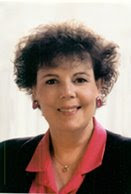I love to embroider. I think it might be because this is
the first skill I every learned. After a lifetime of embroidery I have learned of few things along the way that make it much more enjoyable and successful too.
Not all needles are alike. Poor quality needles are
a real problem. They break, pull when going
through the fabric,
or even cut the threads they are carrying. John James needles are made of the
highest quality iron alloys. Then each needle is nickel plated to reduce the
possibility of rusting, and to provide a smoother surface when passing through
the fabric. The result is a needle the
user never notices, which is as it should be.
Needles are made by:
1.-A wire is drawn down from 5's gauge steel rod.
2.-Then straightened and cut to 2 needle lengths.
3.-Points are then formed on each end.
4.-The impression of 2 eyes is stamped into the wire. Holes are then punched
through both impressions.
5.-The wire is broken into 2 separate needles.
6.-Waste metal from around the eye is removed-this is known as cheeking.
7.- The needles are then hardened.To prevent brittleness, they are subsequently
tempered.
8.-The needles are scoured - this removes burrs from inside the eyes and
polishes them.
9.-The needles are finally nickel plated, inspected, and packaged.
Needles come in a large variety of types and sizes.
There is a bewildering array of needles from which to
choose. Type and size classify hand-sewing needles, with each designed for a
specific use. One size definitely does not fit all! Be sure to choose the type
of needle according to the job it will perform and the size according to the
thread it will hold. Keep in mind that for these hand sewing needles, the
higher the number, the smaller the needle (the opposite of machine needles).
· Betweens
or Quilting needles: Very short, round-eyed needles used to make fine, short,
sturdy stitches. Because these needles are thick, they can better withstand the
stress of stitching through the multiple layers of a quilt. I suggest starting
with an 8 or 9 and gradually progressing to an 11 or 12 as you become more
proficient and your stitches become more even.
· Sharps:
All-purpose, medium length needles with small round eyes commonly used for
applique and general sewing. These are an excellent choice for fine embroidery
and hand sewing because they are easy to thread and slide through fabric with a
minimum of effort.
· Straw
and Milliner needles: Long and slender with small rounded eyes. Many quilters
like them for applique because their flexibility aids in maneuvering the
fabric. Their thinness also makes them a good option for embroidering French
knots.
· Chenille
needles: Short, thick needles with long, oval eyes and sharp points. The longer
eye allows multiple strands of embroidery floss, pearl cotton, or silk ribbon
to be easily threaded. The oversized needle makes a larger hole in the fabric
and helps prevent you from unintentionally crushing silk ribbon or large thread
by forcing it through a too-small hole.
· Tapestry
needles: Short and thick with a large eye and blunt point. The long oval eye
carries silk ribbon and other bulky threads easily. These needles are often
used for wrapped stitches (where the first line of stitching is laid down as
usual and a second thread is wrapped around it, staying on the surface of the
fabric) because the dull point doesn’t pierce the original thread.
· Embroidery
needles: Medium length with long, oval eyes. They have two advantages; the long
eye ensures easy threading and the very sharp point pierces closely woven
fabrics with less effort.
· Beading
needles: Extremely long and fine with a small round eye. Generally they are
used for beading due to their flexibility. This very long, very flexible needle
is hard to control when stitching through fabric so it’s usually used for
stringing beads, not for applying them to fabric.
· Easy
Threading needles: Relatively large needles used when threading needles is a problem.
Machine quilters who tie knots will find these needles handy when burying
thread tails after the knot is tied.
Thread and hand
sewing needleS AND THEIR uses
|
Type of needle
|
Common Sizes
|
Use
|
Thread
|
|
Betweens or quilting needles
|
5 -12
|
Quilting
Beading
Straight stitch
applique
|
Quilting thread
Nymo thread
Embroidery floss
Any heavier machine thread used for quilting
|
|
Sharps
|
10, 11,12
|
General sewing
Applique
Couching
|
Regular sewing thread
Any thread used for applique (silk, machine embroidery
thread)
Threads used for couching (Metallic, rayon, invisible
or any other thread used to hold a very heavy thread on the surface
|
|
Straw or Milliners
|
3 - 11
|
Applique
|
Any thread used for applique (silk, machine embroidery
thread)
|
|
Chenille
|
18 – 24
|
Silk ribbon work
|
Quilting thread
Embroidery floss
Any heavier thread (including silk ribbon) that needs a
larger hole in order to prevent crushing the thread
|
|
Tapestry
|
13 – 26
|
Any stitching requiring a dull-pointed needle that
won’t pierce other threads or yarn
|
|
|
Embroidery
(Crewel)
|
1-10
|
Embroidery
Embellishing Applique
Red work
|
Embroidery floss
Any heavier machine thread
Any heavier hand sewing thread
|
|
Beading
|
10-13
|
Beading
|
Nymo
|
|
Easy threading
|
4-8
|
Machine
quilters use these for hiding thread tails in between the layers
|
Any
|














